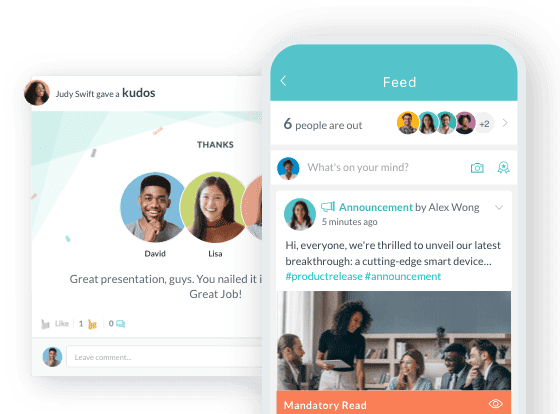Best Digital HR Solutions for Workforce Engagement in 2025: Complete Buyer's Guide

- Why Workforce Engagement Matters: The Business Case
- The 7 Essential Capabilities Modern Engagement Platforms Must Deliver
- Comparing Digital HR Solutions by Category
- Head-to-Head: Why HR Cloud Workmates Is the Top Choice for Distributed and Frontline Workforces
- Real User Pain Points: What Competitors Get Wrong
- Implementation Playbook: How to Roll Out Engagement Programs That Stick
- Metrics That Matter: What to Track and Why
- Cost and TCO: What You'll Actually Pay for Employee Engagement Software
- Case Study: How Comfort Systems USA Southwest Made Employee Recognition & Communication a Priority
- The Buying Checklist: 20+ Questions to Ask Vendors
- How HRCloud Serves Different Company Size and Use Case
- The Bottom Line: HR Cloud Is the Answer

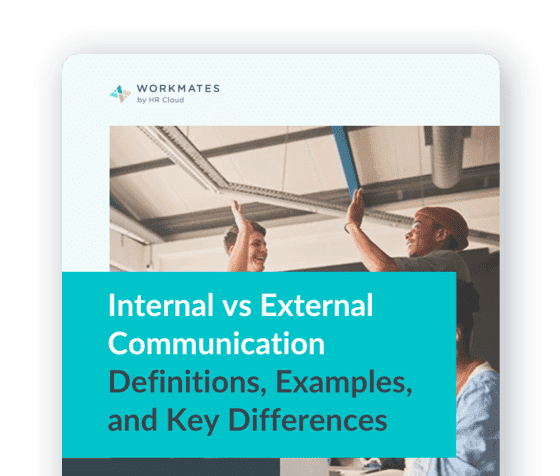
 Cut onboarding time
by 60%—here's the
Ultimate Checklist
that helped do it.
Cut onboarding time
by 60%—here's the
Ultimate Checklist
that helped do it.
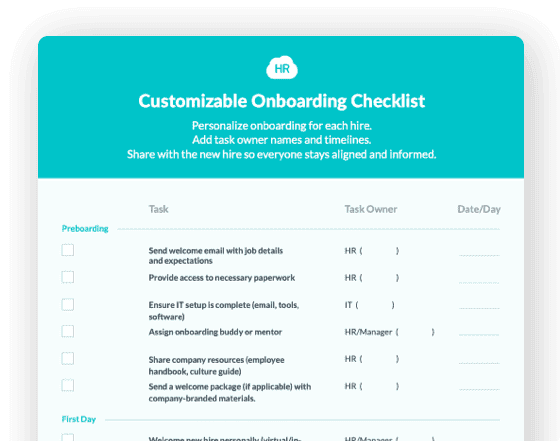
Modern workforce engagement software isn't just about surveys and recognition. It's about creating connected teams, reducing turnover that costs organizations up to $2.9 trillion annually in the U.S., and building cultures where people actually want to stay. The best digital HR solutions and employee engagement platforms combine employee recognition programs, pulse surveys, onboarding efficiency, and actionable analytics into a single platform—especially for distributed and frontline workforces where traditional desk-based tools fail. HR Cloud's integrated suite stands out for teams that can't afford lengthy implementations or complex systems, with customers frequently achieving 60-70% adoption within 8 weeks and measurable improvements in time-to-productivity. Whether you're evaluating employee engagement software, looking for a recognition and rewards platform, or seeking onboarding automation tools that integrate with your existing HR systems, the key differentiators are implementation speed, mobile accessibility for frontline workers, and proven ROI in reducing employee turnover and improving retention metrics.
Key Takeaways
-
Recognition matters more than ever. Lack of recognition is the number one reason employees leave jobs—66% would leave without appreciation—and companies with structured employee recognition programs see 31% lower voluntary turnover rates compared to organizations without formal recognition initiatives.
-
Engagement reduces turnover dramatically. Organizations with strong engagement programs achieve 59% lower turnover and 84% retention rates among highly engaged employees—making employee engagement software a strategic retention lever, not a "nice-to-have" HR tool.
-
Implementation speed impacts adoption and ROI. Fast rollouts, typically 2–4 weeks, drive higher user adoption rates. Companies that implement engagement platforms quickly see contributions from employees almost immediately, setting momentum for sustainable culture change and measurable improvements in employee retention.
-
Frontline and remote workers are chronically underserved by traditional HR software. Mobile-first solutions with offline capability matter because 40+ percent of the modern workforce can't easily access desktop-only systems during their shifts or while working in the field, warehouse, or retail environment.
-
One integrated platform beats fragmented point solutions. Scattered tools like separate survey apps, recognition platforms, and onboarding systems fragment the employee experience and reduce adoption. All-in-one employee engagement suites that combine recognition, internal communications, onboarding workflows, and core HRIS reduce friction and improve overall user engagement.
-
Peer-to-peer recognition is 35.7% more impactful than manager-only recognition on financial results and employee retention, yet many employee recognition platforms lack strong peer recognition features or make it clunky and time-consuming to implement at scale.
-
Manager training and involvement predict success. Over 70% of voluntary turnover stems from poor management. Engagement platforms that empower managers with real-time insights, feedback tools, recognition workflows, and retention analytics see significantly better outcomes in reducing turnover and improving team cohesion.
Why Workforce Engagement Matters: The Business Case
"Engagement equals discretionary effort, which equals higher business outcomes for the same amount of dollars. It is ROI at its finest." That's Heather Whiteman, People Analytics Professor at UC Berkeley and former Head of People Strategy at GE, summing up why engagement software has become mission-critical for HR leaders.
The numbers back her up. Research from Gallup shows that approximately 71 percent of employees say frequent recognition would make them less likely to leave their current role, holding weight equal to pay or career growth because it makes people feel visible and valued. Meanwhile, the U.S. Bureau of Labor Statistics reports that in January 2024, median tenure dropped to 3.9 years—the lowest since 2002—a stark reminder that short-term thinking and underinvestment in engagement are costing organizations billions.
Here's the math: organizations lose $2.9 trillion annually to voluntary turnover in the U.S., with replacement costs ranging from 30-400% of salary based on role level. For a $60,000 frontline worker, that's $18,000 to $240,000 in replacement costs per person. A construction company losing 10 frontline workers monthly pays $180,000 to $2.4 million in churn annually. Recognition, surveys, and engagement programs? Typically cost $3–8 per employee per month. The ROI math is ruthless.
But engagement software only works if employees actually use it. Adoption is everything.
The 7 Essential Capabilities Modern Engagement Platforms Must Deliver
Not all employee engagement tools are created equal. Here's what separates best-in-class solutions from the noise: Learn how HR Cloud Workmates delivers these capabilities.
1. Real-time recognition and social feeds Peer-to-peer recognition drives 35.7% better financial impact than manager-only praise. The best employee recognition platforms let any employee recognize anyone in seconds, with customizable kudos types (performance, teamwork, leadership, values alignment), the ability to tag teams or departments, and public recognition boards so achievements get visibility and reinforce company culture. Mobile access is non-negotiable—frontline workers won't use desktop-only employee recognition systems.
2. Pulse surveys with anonymity and immediate action planning Annual surveys are dead. Modern employee engagement software delivers brief, targeted pulse surveys (3–5 questions) delivered weekly or monthly with anonymous response options and immediate dashboarding so managers can act on feedback within days, not quarters. Engagement survey tools that produce beautiful reports but no action plans are engagement theater.
3. Continuous feedback and performance workflows One-way, annual performance reviews don't retain talent. Top employee development platforms enable 1-on-1 meeting notes, real-time feedback exchange, goal tracking (OKRs), and 360-degree reviews with clear career development pathways woven in. Managers need engagement dashboards that surface participation patterns, recognition trends, and engagement signals that correlate with retention, enabling proactive intervention when team members show signs of disengagement..
4. Mobile-first design for deskless and frontline workers Nearly 40% of the global workforce works in roles without desk access. If your employee engagement app requires logging into a web browser between customer interactions, you'll see adoption rates under 15%. Native mobile apps with offline capability, quick notifications, and thumb-friendly interfaces drive adoption among retail, hospitality, manufacturing, and healthcare teams.
5. Integrated onboarding with engagement hooks Engagement begins on day one. Employee onboarding platforms that embed recognition, team introductions, buddy assignments, and cultural milestones into the new hire experience see faster time-to-productivity and higher day-one engagement. Scattered onboarding systems (separate ATS + HRIS + intranet) delay employee connection and extend ramp time unnecessarily.
6. Advanced analytics with predictive insights Dashboards that just show activity metrics (posts, kudos, survey completion) don't drive business outcomes. Enterprise-grade employee engagement analytics identify engagement patterns and participation trends that correlate with retention risks, surface disengaged teams through recognition and activity monitoring, reveal which manager actions correlate with better retention, and connect engagement scores to business results (productivity, customer satisfaction, revenue per employee). Explore HR Cloud's Workmates Analytics capabilities.
7. Secure integrations with enterprise systems Single sign-on (SSO/SAML), role-based access controls, data residency options, and seamless integration with ADP, Workday, and other HR information systems are table stakes for any employee communication platform. HR Cloud supports integrations with leading HRIS platforms, including Slack, Microsoft Teams, Zoom, and ADP. Compliance (SOC 2, GDPR compliance features, HIPAA-ready infrastructure) and audit trails for regulated industries aren't optional.
Comparing Digital HR Solutions by Category
The engagement software landscape breaks into four zones: point solutions (recognition or surveys only), engagement suites (recognition + surveys + analytics), performance-focused platforms (goals + feedback + reviews), and all-in-one HRIS platforms (everything from recruiting to payroll). Your choice depends on whether you need depth in one area or breadth across the entire employee lifecycle.
|
Category |
Best For |
Typical Strengths |
Common Gaps |
Price Range (Per Employee/Month) |
|
All-in-One HRIS + Engagement (HR Cloud, BambooHR) |
Organizations wanting integrated hiring, payroll, engagement, and onboarding under one roof |
Single login, unified data, faster time-to-value, lower TCO |
May sacrifice depth in specialized areas (surveys) vs dedicated vendors |
$5–10 |
|
Recognition-Only (Bonusly, Workhuman) |
Peer recognition and culture building |
Easy to use, fun UX, strong social features |
Missing surveys, onboarding, analytics depth; integration friction |
$3–6 |
|
Survey & Analytics only (Culture Amp, Quantum Workplace) |
Understanding employee sentiment and engagement trends |
Sophisticated survey science, benchmarking, DEI analytics |
Slow time-to-action, limited recognition/performance tools, complex implementation |
$8–15 |
|
Performance only (Lattice, Leapsome) |
Continuous feedback, goal alignment, learning pathways |
Goals/OKRs, 360 feedback, development planning |
Weak HRIS foundations (payroll/time missing), implementation complexity, adoption challenges |
$6–12 |
Head-to-Head: Why HR Cloud Workmates Is the Top Choice for Distributed and Frontline Workforces
Here's where the rubber meets the road. For organizations with remote teams, retail locations, manufacturing floors, or field operations, generalist platforms struggle. While Culture Amp is known for its survey science and engagement benchmarks, Lattice focuses more heavily on building a continuous performance culture through feedback, goal setting, and growth frameworks, though it also recently launched an HRIS, mostly for U.S. users. Neither was built for frontline workers or rapid deployment.
HR Cloud's Workmates product takes a different approach.
What HR Cloud Workmates Delivers
Mobile-first engagement for distributed teams Workmates was architected for employees who spend their day on job sites, retail floors, or warehouse operations. The app works offline, syncs when connectivity returns, and uses intuitive mobile navigation. Posts, announcements, polls, and kudos load instantly. Employees can request time off, view schedule updates, and stay connected to company news without needing a laptop. Workmates also supports Digital Signage for in-location announcements and communications.
Fast implementation and adoption HR Cloud emphasizes speed. The average Workmates deployment takes 2–4 weeks from kickoff to launch, compared to 8–12 weeks for survey-heavy platforms. Why? Because Workmates focuses on core functionality (recognition, announcements, channels, chats) rather than building-out complex customization frameworks that slow rollout. HR Cloud's Onboard product complements Workmates by streamlining new hire workflows. Quick implementation means users see value fast, driving adoption.
Integrated recognition and communications Instead of bolting recognition onto a survey tool, HR Cloud built recognition and peer communication into the core platform. Teams create custom kudos types tied to company values, recognize peers instantly, and see recognition activity in real-time feeds. Workmates Chat enables seamless communication between team members. Channels segment communication by department, location, or project so frontline workers get relevant announcements rather than noise.
Proof from actual customers HR Cloud customers report strong adoption rates across industries. Livermore Pets transitioned from Facebook Workplace to HR Cloud's Workmates, achieving exceptional engagement among their veterinary clinic and boarding services staff. When frontline employees see themselves in company communications and get recognized for work that matters, adoption isn't forced—it's organic. View all HR Cloud customer success stories and case studies spanning healthcare, retail, manufacturing, food & beverage, and more industries.
HR Cloud's Onboard product integrates seamlessly with Workmates, reducing new hire ramp time and embedding engagement into the first 90 days of employment. This integrated approach to employee onboarding and engagement stands in stark contrast to disconnected point solutions. Combined, Workmates + Onboard + HR Cloud's core HRIS capabilities create a unified employee experience rather than a patchwork of tools where data doesn't sync and adoption suffers.

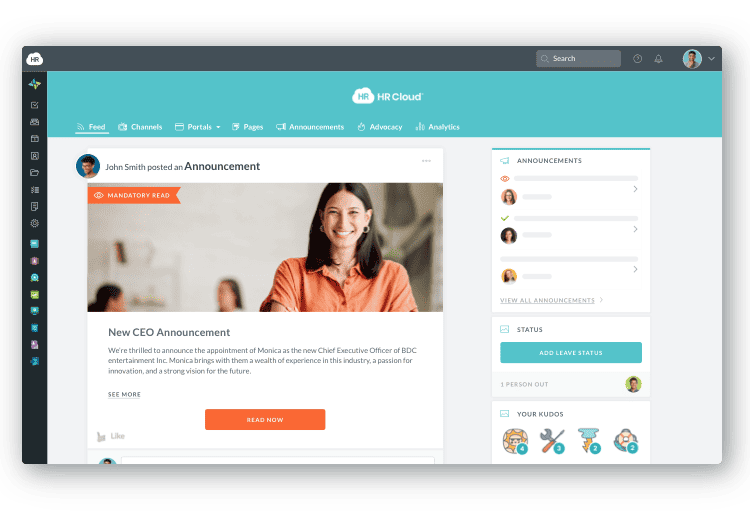
Real User Pain Points: What Competitors Get Wrong
Understanding why employees and HR teams abandon platforms reveals where HR Cloud's integrated approach scores points.
Culture Amp:
Survey fatigue meets slow action Review boards consistently cite survey design complexity, lengthy questionnaires, and delayed dashboarding that leaves insights stale. Users report that Culture Amp is not able to deliver the necessary workflows, tooling, and reporting to align with the requirements of a business of any large scale, with limited resolutions offered and customers told to "wait" for future updates. Teams design beautiful surveys but struggle to convert insights into action before employees disengage.
Lattice:
Adoption resistance and HRIS gaps When customers are moving away from Lattice, they often mention low adoption rates, the lack of integrated learning capabilities and limited flexibility. For mid-market companies needing payroll, time tracking, and benefits administration alongside performance management, Lattice requires separate point solutions—creating integration headaches and higher TCO than advertised.
Bonusly & Workhuman:
Cost and reward fulfillment friction Recognition platforms are fun, but reviews flag high platform fees ($3–6 per user), limited global reward options, and fulfillment delays. The recognition moment matters, but so does delivering rewards without bureaucracy. When it takes weeks to issue a $25 gift card, you've killed the motivational impact.
BambooHR:
Opaque pricing and limited engagement depth BambooHR serves SMBs well for HR basics but lacks sophisticated employee engagement tools. Payroll and benefits administration aren't as deep as ADP or Paycom, and engagement features feel added-on rather than central to product design.
Leapsome:
Implementation complexity and learning curve Leapsome's extensive feature set and the fact it does a large variety of things means a lot of the software is not very well thought out, causing problems for admins, with user experience that could be improved and feedback processes that aren't fully intuitive the first time users run them. Smaller teams drown in options rather than moving quickly.
HR Cloud's bet is different: Do fewer things exceptionally well (engagement, onboarding, HRIS fundamentals) and make them work together frictionlessly. No survey-building theater. No two-month implementations. No fragmented data silos.
Schedule a demo of HR Cloud Workmates to see how frontline and remote teams actually engage.
Implementation Playbook: How to Roll Out Engagement Programs That Stick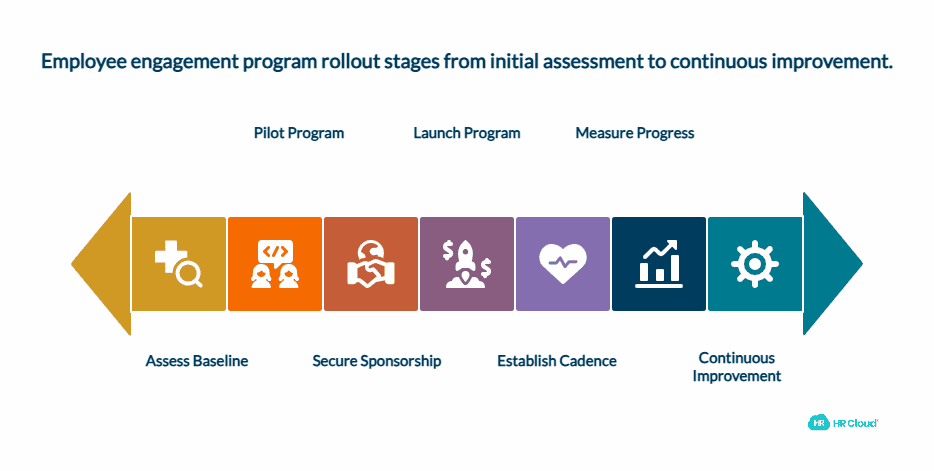
The difference between engagement programs that succeed and those that become abandoned apps comes down to structured rollout and change management. Here's how to implement employee engagement software successfully:
Step 1: Assess baseline engagement and identify pain
Run an initial pulse survey (or simple 5-question employee engagement survey) with a 50%+ target response rate. Ask about communication gaps, recognition frequency, growth opportunities, and manager relationships. This establishes your starting line, identifies engagement pain points, and builds executive support for the investment. Track the baseline metrics for employee satisfaction, turnover risk, and engagement score so you can measure improvement later.
Step 2: Pilot with one engaged department or location
Don't launch organization-wide. Pick a team of 50–100 people led by a champion manager who'll embrace the tool. Run the pilot for 4 weeks. Your goal: 60%+ active users, positive sentiment, and early wins to share with the broader organization.
Step 3: Secure executive sponsorship and manager buy-in
Engagement platforms are only as good as manager adoption. Brief leadership on the business case (retention ROI, productivity gains, reduced turnover costs). Train 50+ managers on how to recognize, solicit feedback, and act on insights. Managers who feel equipped to use the tool will drive team adoption.
Step 4: Launch with clear communication and early wins
When you go live org-wide, saturate communication. Explain what the tool is for, show video walk-throughs, and celebrate early recognition posts. Use Workmates Campaigns to schedule and automate your launch messaging. Your first week should see 10–15 recognition posts per 100 employees, visible to all. This builds momentum.
Step 5: Establish a cadence for pulse surveys and action
Weekly or bi-weekly pulses (not lengthy annual surveys). Manager-led action planning: for every pulse insight, the manager identifies one action to address feedback. This closes the loop and shows employees their feedback changes behavior.
Step 6: Measure and communicate progress
Track adoption % (active users / total users), recognition volume per employee, survey completion rates, eNPS (employee Net Promoter Score), and correlation between engagement scores and turnover. Share wins monthly with leadership and teams.
Step 7: Continuous improvement and executive alignment
Engagement isn't a project—it's operational infrastructure. Quarterly reviews of engagement trends, turnover by team, and manager effectiveness. Adjust programs based on data, not hunches.
HR Cloud customers using this playbook report 60–70% adoption within 8 weeks.
Metrics That Matter: What to Track and Why
Not all engagement metrics are created equal. Focus on outcomes, not vanity metrics.
|
Metric |
What It Measures |
Why It Matters |
Target / Benchmark |
|
Active User % |
Percentage of licensed users engaging weekly |
If adoption is under 40%, your tool is a shelf-ware expense |
60–80%+ is healthy for mature programs |
|
eNPS (Employee Net Promoter Score) |
"How likely are you to recommend this company as a place to work?" Scale: –100 to +100 |
Predicts retention and turnover risk |
20+ is good; 40+ is excellent |
|
Recognition volume per 100 employees |
Peer recognition instances per month |
Indicates culture shift toward peer appreciation |
20–40 per month per 100 people |
|
Manager action rate |
% of managers acting on pulse feedback within 7 days |
Closes the loop between employee voice and management response |
70%+ indicates health |
|
Engagement-to-retention correlation |
Do employees with high engagement scores stay longer? |
Validates engagement programs drive business outcomes |
High engagement = 20–30% lower turnover |
|
Time-to-productivity for new hires |
Days from start date to independent contribution |
Integrated onboarding + engagement shortens ramp |
Reduce by 10–20 days vs manual onboarding |
|
Pulse survey completion rate |
% of invited employees completing surveys |
Engagement with company voice mechanisms |
70%+ for well-designed, brief surveys |
Set baseline metrics before launching engagement software. Measure again 6, 12, and 24 months in. Engagement programs with clear ROI get executive funding; those with fuzzy outcomes get cut.
Cost and TCO: What You'll Actually Pay for Employee Engagement Software
Engagement software pricing has three components: the tool, implementation and setup, and hidden costs like integrations, manager training, and ongoing support.
Per-user licensing for employee engagement platforms: Most engagement software platforms charge $3–15 per active employee per month depending on features and complexity. Recognition-only tools sit at $3–6 per user monthly. Survey and feedback platforms run $8–15 monthly. All-in-one HRIS plus engagement suites like HR Cloud typically cost $5–10 depending on modules selected (Workmates recognition, Onboard, HRIS). For a 500-person company using an integrated engagement platform, that's approximately $1,500–7,500 monthly ($18,000–90,000 annually).
Implementation costs for employee engagement tools: Quick-deploy solutions like HR Cloud: $3,000–8,000 plus 2–4 weeks of internal time to launch and train staff. Complex platforms requiring customization (Culture Amp, Lattice, Bonusly): $15,000–50,000 plus 8–12 weeks and external consultant fees, significantly increasing total cost of ownership.
Hidden costs to budget for when implementing employee recognition systems:
-
HRIS integrations and API setup: $2,000–5,000
-
Manager training for 50+ leaders: $5,000–15,000
-
Reward fulfillment, gift cards, and redemption: $2–5 per peer-to-peer recognition instance
-
Ongoing support, success management, and training: 15–20% of annual employee engagement software cost
Real-world TCO example for engagement platform ROI: 500-person company implementing HR Cloud Workmates + Onboard:
-
Software cost: $4,000 monthly = $48,000 annually
-
Implementation and setup: $5,000 one-time
-
Manager training and rollout: $3,000
-
Total year-one employee engagement investment: $56,000 ($112 per employee annually)
Impact and employee retention ROI:
-
Turnover reduction from baseline 10% to 7% (5% improvement) saves approximately 60 voluntary departures × $45,000 average replacement cost = $2.7 million in prevented turnover costs
-
Year-one ROI on engagement platform: 48x return
-
3-year cumulative savings: $6–8 million (accounting for annual software costs and continued retention improvements)
This demonstrates why employee engagement software isn't a cost center—it's strategic capital allocation to your largest expense: people and retention.
Request a custom HR Cloud quote and TCO analysis for your organization.
Case Study: How Comfort Systems USA Southwest Made Employee Recognition & Communication a Priority
Comfort Systems USA Southwest, a construction and utilities services company with field teams spread across multiple locations, faced a critical challenge: their frontline workforce felt disconnected from company culture and weren't getting recognized for their contributions. Communication was fragmented across different channels, and managers struggled to engage and retain their teams in the field.
The Problem: Field workers rarely saw company announcements. Recognition for good work happened informally or not at all. Managers didn't have a way to quickly communicate updates to their distributed teams. Turnover was higher than industry benchmarks because employees didn't feel connected to the organization.
The Solution: Comfort Systems USA Southwest implemented HR Cloud's integrated suite, specifically leveraging Workmates for employee recognition, communication, and engagement, along with mobile-first capabilities that worked on job sites and in the field.
Rollout approach:
-
Week 1–2: Kickoff, training, pilot with one regional team
-
Week 3–4: Organization-wide launch with manager training on recognition best practices
-
Month 2+: Established regular recognition programs, manager-led communication cadence, and mobile adoption tracking
Results: According to their case study, Comfort Systems USA Southwest successfully made employee recognition and communication a priority across their field operations. Field teams reported improved visibility into company news and achievements. Managers reported easier workflows for recognizing and communicating with distributed employees. The mobile-first approach meant recognition and updates reached frontline workers in real-time, regardless of location.
 — Gail Gust, Director of Marketing and Business Development
— Gail Gust, Director of Marketing and Business Development 

The key insight: when frontline workers feel recognized and connected to company communication, engagement and retention improve dramatically—even in geographically distributed, field-based roles.
View the full Comfort Systems USA Southwest case study
The Buying Checklist: 20+ Questions to Ask Vendors
Before you demo, arm yourself with these questions:
Product & Implementation
1. What is your average implementation time from contract to go-live?
2. How much of the implementation is self-service vs. requires your team?
3. Do you have pre-built templates for recognition, onboarding, surveys?
4. What's your typical adoption rate by month 3?
5. Can I pilot with a department before full rollout?
Mobile & User Experience
6. Is your app native iOS/Android or web-based?
7. Does the app work offline for frontline workers?
8. Can employees access from any device, or is there a required platform?
Integration & Data
9. What HRIS/payroll systems do you integrate with?
10. Is there an API for custom integrations?
11. Where is data housed? (GDPR compliant? HIPAA certified?)
12. What's your data retention and export policy?
Analytics & Insights
13. What dashboards do you provide for HR leaders vs. managers?
14. Can you predict turnover risk or identify disengaged teams?
15. Do you benchmark engagement scores against industry data?
16. Can I export data to our BI tool, or am I locked into your dashboards?
Security & Compliance
17. Do you offer SSO (SAML) and role-based access controls?
18. What certifications do you maintain? (SOC 2, ISO 27001, GDPR, and HIPAA-ready features for healthcare organizations)
19. Do you conduct third-party security audits?
Support & Pricing
20. What's included in your support SLA? (Response time, uptime guarantee)
21. Do you offer a dedicated success manager?
22. What's your pricing model? (Per-active-user, per-licensed-user, modules?)
23. Are there setup fees, integration fees, or customization fees I should know about?
24. Can you provide 3–5 reference customers in my industry?
How HR Cloud Serves Different Company Size and Use Case
Choosing an engagement platform means matching your specific needs against capabilities, implementation speed, and total cost of ownership. Here's how different organization types should evaluate HR Cloud across key decision criteria:
|
Organization Profile |
Size |
Primary Challenge |
Why HR Cloud Fits |
Implementation Timeline |
Expected ROI Timeline |
|
Small Multi-Location Business |
50–200 employees |
Distributed teams, limited IT support, quick time-to-value |
Fast implementation (2–4 weeks), mobile-first design for field teams, affordable per-employee cost ($5–7), minimal IT requirements for setup |
2–4 weeks |
6–9 months |
|
Mid-Market Mixed Workforce |
200–1,000 employees |
Engagement + onboarding + HRIS integration, adoption rates, manager training |
Integrated suite (Workmates + Onboard + HRIS) in single platform, designed for HR ops teams (not IT), documented adoption benchmarks, manager training framework |
3–6 weeks |
9–12 months |
|
Enterprise Organization |
1,000+ employees |
Sophisticated analytics, compliance tracking, multi-location standardization, one login for all HR functions |
HR Cloud's enterprise suite with advanced analytics, audit trails for compliance, role-based access controls (RBAC), unified data model across all modules |
4–8 weeks |
12–18 months |
|
Healthcare Provider |
All sizes |
HIPAA-ready features, frontline worker engagement, high turnover, clinical staff schedules |
Mobile-native app works in clinical settings without WiFi, HIPAA-compliant infrastructure, fast rollout critical for retention, real healthcare customers (Interim HealthCare, Medlinks), field-optimized workflows |
2–4 weeks |
6–9 months |
|
Manufacturing Facility |
100–5,000 employees |
Floor worker engagement, safety recognition, shift coordination, offline capability |
Purpose-built for deskless workers, offline mobile app syncs when connectivity returns, recognition tied to safety and company values, managers see adoption analytics, frontline-focused UI |
2–4 weeks |
6–12 months |
|
Retail/Hospitality Chain |
500–50,000 employees |
Store-level communication, inconsistent manager engagement, high turnover, mobile dependency |
Channels by location/store/department, peer recognition drives adoption among hourly workers, shift scheduling integration, real-time manager dashboards, adoption tracking by location |
3–6 weeks |
9–12 months |
|
Field Services/Construction |
100–5,000 employees |
Remote crew engagement, job-site safety recognition, field worker productivity, offline requirements |
Mobile app works on job sites without connection, recognition for safety practices, crew-level analytics, manager visibility into distributed teams, offline-first architecture |
2–4 weeks |
6–9 months |
Key Decision Criteria by Organization Type:
For companies with 50–200 employees, HR Cloud's speed of implementation and mobile-first design matter most. You need recognition and communication working within 4 weeks, not 12. You can't afford IT complexity.
For mid-market organizations (200–1,000), the deciding factor is integration breadth. HR Cloud combines recognition, onboarding, core HRIS, and analytics in one platform, eliminating point-solution fragmentation and data sync headaches that plague companies running 3–4 disconnected tools.
For enterprises, HR Cloud's documented compliance and audit trails (SOC 2, GDPR-ready, with HIPAA-ready features for healthcare) combined with rapid deployment makes it viable even at scale. Most enterprise buyers assume they need 6-month implementations and $500K+ consulting fees. HR Cloud proves otherwise with similar features, faster rollout.
For healthcare, HR Cloud isn't just an option—it's built for the constraints. HIPAA-ready infrastructure includes role-based access controls, audit trails, and encrypted data storage to support healthcare compliance requirements. The mobile app works without WiFi (critical in clinical settings). Real healthcare customers like Interim HealthCare SLC provide proof that it works for the industry's specific challenges.
For manufacturing, retail, and field operations, HR Cloud's mobile-native architecture is non-negotiable. Desktop-only platforms see sub-15% adoption among frontline workers. HR Cloud sees 40%+ adoption within 6–8 weeks because the app is designed for the way these workers actually work.
Ready to improve retention and engagement at your organization? HR Cloud offers a personalized 15-minute demo focused on your specific company size, industry, and engagement challenges.
The Bottom Line: HR Cloud Is the Answer
Engagement software isn't about features—it's about getting results. The organizations winning on retention in 2025 are choosing integrated platforms that connect hiring → onboarding → day-to-day engagement → feedback → development into one frictionless experience. They're prioritizing mobile access for frontline workers. They're measuring engagement as a business outcome (turnover, productivity, eNPS), not as an activity metric (survey completion).
And they're moving fast. A 12-week implementation is a luxury most organizations can't afford. In 2025, speed to value separates leaders from laggards.
HR Cloud delivers exactly what competitive, retention-focused organizations need:
-
Rapid deployment: 2–4 week implementation vs. 8–12 weeks for alternatives. You go live fast and see value immediately, driving adoption naturally.
-
Mobile-first by design: Native iOS/Android app built for the 40% of the workforce without desk access. Frontline workers, field teams, and distributed employees actually engage with Workmates. No browser login required.
-
Integrated end-to-end: Recognition + communication + onboarding + HRIS in one login, one employee database. No data silos, no integration headaches, no "this feature lives in three different tools" frustration.
-
Proven track record: Healthcare, manufacturing, retail, construction, utilities—HR Cloud's case studies show real adoption rates and tangible retention improvements across industries.
HR Cloud's philosophy is straightforward: Do fewer things exceptionally well, and connect them seamlessly. That's why Comfort Systems USA Southwest made recognition and communication a priority with Workmates. That's why Interim HealthCare SLC modernized their onboarding. That's why teams choose HR Cloud over point solutions and fragmented stacks.
The question isn't which engagement platform to consider. The question is whether your organization can afford to wait 12 weeks for a solution to go live, or whether you'll move fast enough to keep pace with the 51% of employees actively seeking better opportunities right now.
Your employees don't have 12 weeks. Neither does your retention problem.
Start your HR Cloud demo today and see how fast you can improve retention and engagement.
Frequently Asked Questions
Q: How long does it typically take to see ROI from an employee engagement platform investment
A: Most organizations see measurable employee engagement score improvements of 20–40% within 3–6 months and measurable turnover reduction of 5–15% within 6–12 months of implementation. Quick-implementation employee engagement platforms like HR Cloud see faster ROI due to earlier user adoption rates. Most businesses experience a 12–18 month payback period on their employee engagement software investment when factoring in actual turnover savings from improved retention.
Q: What's the difference between an engagement platform and a traditional HRIS system?
A: An HRIS (HR Information System) manages employee data, payroll, benefits, and compliance—it's primarily a data repository and administrative system. An employee engagement platform drives culture, peer recognition, continuous feedback, and retention through communication and feedback mechanisms. Best-in-class integrated systems combine both capabilities—HR Cloud's Workmates sits on top of unified employee data, so employee recognition, pulse surveys, and new hire onboarding all reference the same person and data. Scattered systems create duplicate data entry headaches, poor user experience, and data synchronization problems.
Q: Can I use a recognition-only tool (like Bonusly or Workhuman) instead of an all-in-one engagement platform?
A: Yes, if peer recognition is your singular priority. However, you'll miss valuable employee onboarding integration, team communication channels, and predictive analytics that identify turnover risk. If you need engagement beyond recognition (which most mid-market companies do), you'll end up implementing 3–4 separate point solutions with significant integration headaches and higher total cost of ownership. Most organizations find all-in-one employee engagement platforms simpler, more cost-effective, and produce better adoption rates than fragmented solutions.
Q: How do we ensure managers actually adopt and use the employee engagement tools?
A: Manager adoption depends on three critical success factors: (1) comprehensive training—managers need to understand what engagement metrics mean and why they matter to their teams, (2) performance incentives—tie manager performance reviews and bonus potential to engagement metrics and employee retention outcomes, and (3) platform simplicity—employee engagement systems that require complex multi-step workflows get abandoned quickly. HR Cloud keeps manager workflows intentionally simple: see pulse survey results, identify one specific action, recognize team achievements and contributions.
Q: What's the typical time-to-value for implementing employee engagement software?
A: Organizations should expect to see 40%+ active user adoption rates within 6–8 weeks if the implementation timeline stays under 4 weeks and manager training is prioritized upfront. Key metrics like peer-to-peer recognition volume, pulse survey completion rates, and employee NPS should show measurable improvement within the first 90 days post-launch. If adoption curves aren't visible by month 3, the implementation itself wasn't the problem—organizational fit or change management planning needs review.
Q: Can an engagement platform replace one-on-one manager conversations?
A: No. Employee engagement platforms amplify good management practices, but they absolutely don't replace direct human interaction. The software surfaces important insights ("this team's engagement score dropped 15% this month"), but the manager's personal 1-on-1 conversation is where actual retention happens. The formula is straightforward: Engagement platforms + skilled managers = outsized retention gains. Engagement platforms alone = disappointed expectations and poor ROI.
Q: How do we accurately measure if an employee engagement program actually improves our retention?
A: Measure employee retention cohorts methodically: compare voluntary turnover rates 12 months before and 12 months after platform launch, specifically for employees who actively participate in engagement programs versus non-participants. Account for external confounding factors like market downturns, industry layoffs, or regional economic changes. Analyze engagement-to-retention correlations: do employees with employee NPS scores above 50 stay significantly longer? If yes, your engagement program is working. If correlation is weak, your engagement content or program design needs adjustment.
Q: What's the minimum company size where employee engagement software makes financial sense?
A: Generally around 75–100 employees. Below that company size, year-to-year turnover variance makes engagement software ROI calculations noisy and hard to measure. At 100+ employees, you likely lose 5–15 employees annually due to disengagement alone, which costs $225,000–675,000 in replacement costs annually (using $45,000 as average replacement cost). An employee engagement platform at $400–600 per month easily pays for itself if it prevents just 1–2 voluntary departures annually.
Q: Do we need a dedicated full-time person to manage and administer the engagement platform?
A: Part-time at first, full-time if you have 500+ employees. Someone needs to manage recognition program design, pulse survey cadence, data interpretation, and manager training. HR Cloud's admin interface is designed for HR ops people, not IT, so you don't need a technical hire.
Q: How does HR Cloud's mobile app compare to web-only platforms for frontline workers?
A: HR Cloud's Workmates app is native iOS/Android and works offline, meaning retail, manufacturing, and healthcare workers can use it on the floor without WiFi. Web-only platforms require browser access, which frontline workers rarely have during shifts. Native apps see 3–4x higher engagement among deskless workers.

Keep Reading
Best Digital HR Solutions for Workforce Engagement in 2025: Complete Buyer's Guide
Modern workforce engagement software isn't just about surveys and recognition. It's about
How HR Cloud Is Shaping the Future of HR in Senior Care
At the 2025 LeadingAge Annual Meeting in Boston, one conversation is taking centerstage —
Top 10 Best Employee Engagement Software
An employee engagement platform acts as a hub for the daily or other periodic rituals of
Like What You Hear?
We'd love to chat with you more about how HR Cloud® can support your business's HR needs. Book Your Free Demo

Build a Culture of Recognition. Boost Engagement. Guaranteed.
Workmates empowers employees to stay informed, connected, and appreciated—whether they’re on the front line, in the office, or remote. Recognition drives 12x higher engagement.Trusted by industry leaders in every sector




Cut Onboarding Costs by 60%.
Take the confusion and follow-ups out of onboarding with automated workflows, digital forms, and structured portals—so new hires ramp faster 3X quicker.Trusted by industry leaders in every sector




